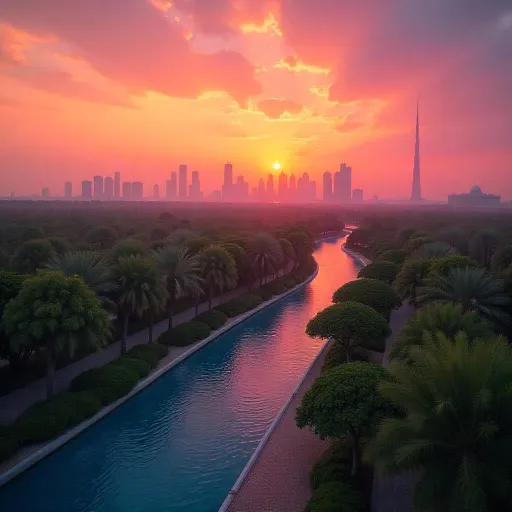Between January and June 2025, Dubai planted over 300,000 trees across key roadways and intersections as part of a major AED190 million landscaping initiative. The project transformed more than 3 million square metres of land, reinforcing the city’s identity through greenery and smart infrastructure while contributing to long-term environmental goals.

Strategic Locations and Native Flora
The afforestation effort targeted prominent roads and intersections including Sheikh Zayed Road, Sheikh Rashid Street, Al Khail Road, and others. Dubai Municipality selected a mix of native and ornamental species—such as sidr, ghaf, neem, chorisia, and bougainvillaea—ensuring a balance between climate resilience and aesthetic appeal. Additionally, 222,500 square metres of ground cover and seasonal flowers were planted to beautify and diversify the green space.
Smart Irrigation and Tech-Enabled Maintenance
Supporting the vast plantation is a network of underground irrigation systems managed through IoT-enabled controls. These smart systems allow real-time water monitoring, minimizing waste and ensuring consistent hydration in Dubai’s arid climate. The irrigation setup represents a model of sustainable urban landscaping, using less water while maintaining large-scale greenery.
Urban Identity Meets Environmental Function
According to Bader Anwahi, CEO of the Public Facilities Agency, the project reflects a deliberate urban strategy. Plants were grown in Dubai Municipality’s own nurseries, and fencing around entrances was color-coordinated to create a cohesive city identity. The initiative aligns with the Dubai 2040 Urban Master Plan and the Green Dubai vision, aiming to enhance sustainability and liveability citywide.
Manpower and Machinery Behind the Project
Executing a project of this scale in just six months required coordinated efforts from hundreds of professionals—landscape planners, nursery staff, irrigation engineers, field workers, and equipment operators. From soil preparation to tree transport and smart irrigation setup, every step was managed with precision to meet both environmental and urban design goals.
More Than Just Landscaping
The budget of AED190 million covered not just trees and flowers, but also soil engineering, irrigation infrastructure, smart monitoring systems, decorative lighting, and fencing. Lighting elements, like those at the Al Khail–Latifa bint Hamdan junction, were designed to enhance the city’s visual appeal and even change color during national events.
Sustained Growth and Green Goals
Dubai’s green coverage expanded significantly—from 234 hectares in 2023 to 391.5 hectares in 2024, a 67% growth in just one year. By early 2025, Dubai Municipality was maintaining 5.5 million trees and seedlings, along with millions of square metres of ground cover and flower beds. These figures show the scale of Dubai’s green transformation and its aim to integrate greenery into both infrastructure and lifestyle.
Dubai Municipality at the Core of the Vision
Founded in 1954, Dubai Municipality is the central authority behind this massive transformation. Beyond landscaping, it manages urban planning, public parks, waste management, health systems, and urban heritage. With 4 agencies and 37 departments operating under its umbrella, the Municipality delivers over 150 public services and manages more than 800 daily operations—all contributing to a greener, more livable Dubai.
Greening the Desert with Vision and Precision
Dubai’s large-scale tree plantation isn’t just a beautification effort—it’s a bold statement in climate adaptation, sustainability, and city planning. By combining native resilience, smart irrigation, urban design, and civic pride, the city is turning its desert into a symbol of green innovation.
